Text
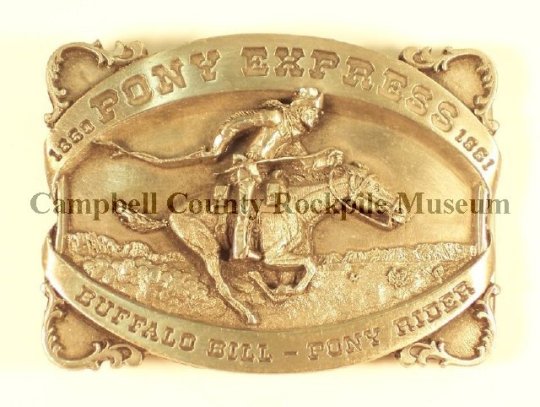
April 3, 1860 - Pony Express debuts
"On April 3, 1860, the first Pony Express mail, traveling by horse and rider relay teams, simultaneously leaves St. Joseph, Missouri, and Sacramento, California. Ten days later, on April 13, the westbound rider and mail packet completed the approximately 1,800-mile journey and arrived in Sacramento, beating the eastbound packet’s arrival in St. Joseph by two days and setting a new standard for speedy mail delivery. Although ultimately short-lived and unprofitable, the Pony Express captivated America’s imagination and helped win federal aid for a more economical overland postal system. It also contributed to the economy of the towns on its route and served the mail-service needs of the American West in the days before the telegraph or an efficient transcontinental railroad.
The Pony Express debuted at a time before radios and telephones, when California, which achieved statehood in 1850, was still largely cut off from the eastern part of the country. Letters sent from New York to the West Coast traveled by ship, which typically took at least a month, or by stagecoach on the recently established Butterfield Express overland route, which could take from three weeks to many months to arrive. Compared to the snail’s pace of the existing delivery methods, the Pony Express’ average delivery time of 10 days seemed like lightning speed.
The Pony Express Company, the brainchild of William H. Russell, William Bradford Waddell and Alexander Majors, owners of a freight business, was set up over 150 relay stations along a pioneer trail across the present-day states of Missouri, Kansas, Nebraska, Wyoming, Colorado, Utah, Nevada and California. Riders, who were paid approximately $25 per week and carried loads estimated at up to 20 pounds of mail, were changed every 75 to 100 miles, with horses switched out every 10 to 15 miles. Among the riders was the legendary frontiersman and showman William “Buffalo Bill” Cody (1846-1917), who reportedly signed on with the Pony Express at age 14. The company’s riders set their fastest time with Lincoln’s inaugural address, which was delivered in just less than eight days.
The initial cost of Pony Express delivery was $5 for every half-ounce of mail. The company began as a private enterprise and its owners hoped to gain a profitable delivery contract from the U.S. government, but that never happened. With the advent of the first transcontinental telegraph line in October 1861, the Pony Express ceased most of its operations. However, the legend of the lone Pony Express rider galloping across the Old West frontier to deliver the mail lives on today.
-- History.com
This week in History:
March 31, 1889 - Eiffel Tower Opens
April 1, 1700 - April Fools Tradition Popularized
April 2, 1917 - Jeanette Rankin, first woman elected to U.S. Congress, assumes office
April 4, 1968 - Dr. Martin Luther King Jr assassinated
April 5, 1792 - George Washington exercises first presidential veto
This belt buckle depicting Buffalo Bill, one of the Pony Express Riders, can be found in the online collection of the Campbell County Rock Pile Museum.
#Museums#Wyoming Museums#Museum Collections#Wyoming history#this day in history#online museum collections#pony express#buffalo bill#history museums#PastPerfect#PastPerfect Online
0 notes
Text
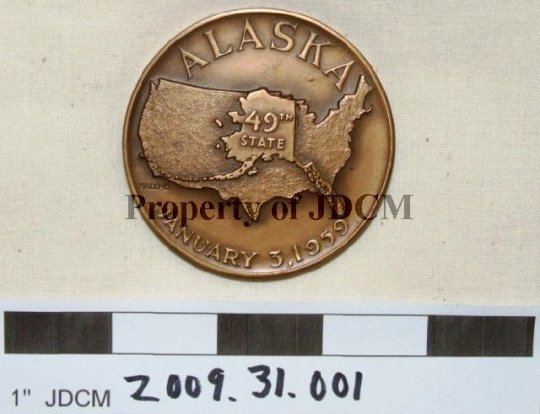
January 3, 1959: Alaska admitted into Union
"On January 3, 1959, President Eisenhower signs a special proclamation admitting the territory of Alaska into the Union as the 49th and largest state.
Indigenous peoples inhabited the region that would become Alaska for centuries. The European discovery of Alaska came in 1741, when a Russian expedition led by Danish navigator Vitus Bering sighted the Alaskan mainland. Russian hunters were soon making incursions into Alaska, and the native Aleut population suffered greatly after being exposed to foreign diseases. In 1784, Grigory Shelikhov established the first permanent Russian colony in Alaska on Kodiak Island. In the early 19th century, Russian settlements spread down the west coast of North America, with the southernmost fort located near Bodega Bay in California.
Russian activity in the New World declined in the 1820s, and the British and Americans were granted trading rights in Alaska after a few minor diplomatic conflicts. In the 1860s, a nearly bankrupt Russia decided to offer Alaska for sale to the United States, which earlier had expressed interest in such a purchase. On March 30, 1867, Secretary of State William H. Seward signed a treaty with Russia for the purchase of Alaska for $7.2 million. Despite the bargain price of roughly two cents an acre, the Alaskan purchase was ridiculed in Congress and in the press as “Seward’s folly,” “Seward’s icebox,” and President Andrew Johnson’s “polar bear garden.” Nevertheless, the Senate ratified purchase of the tremendous landmass, one-fifth the size of the rest of the United States.
Despite a slow start in settlement by Americans from the continental United States, the discovery of gold in 1898 brought a rapid influx of people to the territory. Alaska, rich in natural resources, has been contributing to American prosperity ever since.
-History.com
This week in History:
January 1, 1863: Abraham Lincoln signs the Emancipation Proclamation
January 2, 1974: President Nixon signs national speed limit into law
January 5, 1920: New York Yankees announce purchase of Babe Ruth
January 6, 1838: Samuel Morse unveils the telegraph
This Commemorative Medal celebrating Alaska's statehood can be found in the online collection of the Juneau-Douglas City Museum.
#American History#History#alaska#statehood#alaska history#museums#alaska museums#museum collections#online museum collections#pastperfect#pastperfect online
1 note
·
View note
Text

October 4, 1927: Work begins on Mount Rushmore
"On October 4, 1927, sculpting begins on the face of Mount Rushmore in the Black Hills National Forest of South Dakota. It would take another 12 years for the granite images of four of America’s most revered presidents—George Washington, Thomas Jefferson, Abraham Lincoln and Theodore Roosevelt—to be completed.
The monument was the brainchild of a South Dakota historian named Doane Robinson, who was looking for a way to attract more tourists to his state. He hired a sculptor named Gutzon Borglum to carve the faces into the mountain. The Lakota Sioux people, who consider the Black Hills to be sacred ground, strongly opposed the project. The mountain was previously part of the Great Sioux Reservation before being taken away from them by the U.S. government.
According to the National Park Service, the first face to be chiseled was George Washington’s; Borglum first sculpted the head as an egg shape, his features added later. Thomas Jefferson’s image was originally fashioned in the space to the right of Washington, but, within two years, the face was badly cracked. Workers had to blast the sculpture off the mountain using dynamite. Borglum then started over with Jefferson situated on the left side of Washington.
Washington’s face was the first to be completed in 1934. Jefferson’s was dedicated in 1936—with then-president Franklin Roosevelt in attendance—and Lincoln’s was completed a year later. In 1939, Teddy Roosevelt’s face was completed. The project, which cost $1 million, was funded primarily by the federal government.
Borglum continued to touch up his work at Mount Rushmore until he died suddenly in 1941. Borglum had originally hoped to also carve a series of inscriptions into the mountain, outlining the history of the United States."
-- History.com
This month in history:
October 3, 1990 - East and West Germany reunite after 45 years
October 5, 1947 - Harry Truman delivers first-yever presidental speech on TV
October 13, 1792 - White House cornerstone laid
October 18, 1867 - United States takes possession of Alaska territory
October 26, 1825 - Erie Canal opens
This photograph of Mount Rushmore in process of carving, can be found in the online collection of Minnilusa Historical Association.
#this day in history#this month in history#museum collections#online museum collections#south dakota history#mount rushmore#history museums#museums#pastperfect#pastperfect online#minnilusa historical association#south dakota museums#mountain west museums
0 notes
Photo

June 30, 1859: Daredevil crosses Niagara Falls on tightrope
Jean Francois Gravelet, a Frenchman known professionally as Charles Blondin, becomes the first daredevil to walk across Niagara Falls on a tightrope. The feat, which was performed 160 feet above the Niagara gorge just down river from the Falls, was witnessed by some 5,000 spectators. Wearing pink tights and a yellow tunic, Blondin crossed a cable about two inches in diameter and 1,100-feet long with only a balancing pole to protect him from plunging into the dangerous rapids below.
It was the first in a series of famous Niagara tightrope walks performed by “The Great Blondin” from 1859 to 1860. These “ascensions,” as he advertised them, always had different theatrical variations, including doing tightrope walks blindfolded, in a sack, with his manager on his back, sitting down midway to cook an omelet, and pushing a wheelbarrow across while dressed as an ape. In 1861, he performed at the Crystal Palace in London, turning somersaults on stilts on a rope stretched 170 feet above the ground. He died in 1897.
This souvenir card depicting Blondin crossing the Niagara River can be found in the online collection of the Niagara Falls Museums.
#this day in history#this week in history#museums#canadian museums#niagara falls museums#niagara falls#history#daredevils#museum collections#online collections#pastperfect#pastperfect online
1 note
·
View note
Photo

April 05, 1933-- FDR creates Civilian Conservation Corps
"On April 5, 1933, President Franklin D. Roosevelt establishes the Civilian Conservation Corps (CCC), an innovative federally funded organization that put tens of thousands of Americans to work during the Great Depression on projects with environmental benefits.
In 1932, FDR took America’s political helm during the country’s worst economic crisis, declaring a “government worthy of its name must make a fitting response” to the suffering of the unemployed. He implemented the CCC a little over one month into his presidency as part of his administration’s “New Deal” plan for social and economic progress. The CCC reflected FDR’s deep commitment to environmental conservation. He waxed poetic when lobbying for the its passage, declaring “the forests are the lungs of our land [which] purify our air and give fresh strength to our people.”
The CCC, also known as “Roosevelt’s Tree Army,” was open to unemployed, unmarried U.S. male citizens between the ages of 18 and 26. All recruits had to be healthy and were expected to perform hard physical labor. Blacks were placed in de-facto segregated camps, although administrators denied the practice of discrimination. Enlistment in the program was for a minimum of 6 months; many re-enlisted after their first term. Participants were paid $30 a month and often given supplemental basic and vocational education while they served. Under the guidance of the Departments of the Interior and Agriculture, CCC employees fought forest fires, planted trees, cleared and maintained access roads, re-seeded grazing lands and implemented soil-erosion controls. They built wildlife refuges, fish-rearing facilities, water storage basins and animal shelters. To encourage citizens to get out and enjoy America’s natural resources, FDR authorized the CCC to build bridges and campground facilities. From 1933 to 1942, the CCC employed over 3 million men.
Of Roosevelt’s many New Deal policies, the CCC is considered by many to be one of the most enduring and successful. It provided the model for future state and federal conservation programs. In 1942, Congress discontinued appropriations for the CCC, diverting the desperately needed funds to the effort to win World War II."
- History.com
This Civilian Conservation Corps Ring from 1940 can be found in the online collection of the National Museum of Forest Service History.
#this day in history#ccc#Civilian Conservation Corps#US Forest Service#Forest Service#Museums#history museums#PastPerfect#PastPerfect Online#Online Museum Collections#Montana Museums#US Museums#history#US History
6 notes
·
View notes
Photo

January 16, 1919: Prohibition is ratified by the states
"The 18th Amendment to the U.S. Constitution, prohibiting the “manufacture, sale, or transportation of intoxicating liquors for beverage purposes,” is ratified by the requisite number of states on January 16, 1919.
The movement for the prohibition of alcohol began in the early 19th century, when Americans concerned about the adverse effects of drinking began forming temperance societies. By the late 19th century, these groups had become a powerful political force, campaigning on the state level and calling for total national abstinence. In December 1917, the 18th Amendment, also known as the Prohibition Amendment, was passed by Congress and sent to the states for ratification.
Nine months after Prohibition's ratification, Congress passed the Volstead Act, or National Prohibition Act, over President Woodrow Wilson's veto. The Volstead Act provided for the enforcement of prohibition, including the creation of a special unit of the Treasury Department. One year and a day after its ratification, prohibition went into effect—on January 17, 1920—and the nation became officially dry.
Despite a vigorous effort by law-enforcement agencies, the Volstead Act failed to prevent the large-scale distribution of alcoholic beverages, and organized crime flourished in America. In 1933, the 21st Amendment to the Constitution was passed and ratified, repealing prohibition."
- History.com
This photograph of a captured liquor still can be found in the online collection of the Texas Ranger Hall of Fame and Museum.
#American History#Prohibition#History Museums#History#Texas Museums#Online Museum Collections#PastPerfect#PastPerfect Online#Museums
1 note
·
View note
Photo

October 31, 1950 - Earl Lloyd becomes first Black player in the NBA
"On October 31, 1950, 21-year-old Earl Lloyd becomes the first African American to play in an NBA game when he takes the court in the season opener for the Washington Capitols.
Lloyd grew up in Jim Crow Virginia and went to West Virginia State, where he was the star of the school’s championship basketball team. He didn’t know he’d been drafted by the NBA until he ran into a friend on campus who told him she’d heard a rumor that he’d be moving to Washington. It turned out that the Capitols had picked him in the ninth round of the draft. Two other Black players joined the NBA that season—the Celtics drafted Chuck Cooper in the second round and the New York Knicks got Nat “Sweetwater” Clifton from the Harlem Globetrotters—but the Knicks and the Celts didn’t start their seasons until November. As a result, Lloyd became a coincidental pioneer: the first Black player to make his debut in the NBA.
Joining an all-white team was intimidating, Lloyd remembered, but his teammates—most of whom had played on integrated college teams—were immediately welcoming. Some fans, however, were less kind. As the announcer read the Capitols’ lineup on that first night of the season, a white man in the front row used a racial slur.
After seven games with the Capitols, Lloyd was drafted into the military and sent to Korea for two years. When he returned to the United States, the Capitols had gone out of business, and so he went to play for the Syracuse Nationals (who later became the Philadelphia 76ers). He wrapped up his nine-season career in Detroit. After he retired from playing, he stayed in the Motor City, serving as a scout and then as an assistant coach for the Pistons. In 1970, he became the first full-time black head coach in the league. He coached the Detroit team for a year, and then went on to work for the city, in the police department and as a school administrator. He was inducted into the Basketball Hall of Fame in 2003. He died in 2015."
- History.com
This Month in History:
October 1, 1890 - Yosemite National Park established
October 7, 1985 - Lynette Woodard becomes first female Harlem Globetrotter
October 24, 1901 - First barrel ride down Niagara Falls
October 28, 1904 - New York City subway opens
This biography of Earl Lloyd and other photographs can be found in the online collection of Historic Alexandria.
#Museums#Virginia Museums#african american history#basketball#history museums#pastperfect#pastperfectonline#this day in history#this month in history
3 notes
·
View notes
Photo

July 4, 1884 - France gives the Statue of Liberty to the United States
"In a ceremony held in Paris on July 4, 1884, the completed Statue of Liberty is formally presented to the U.S. ambassador as a commemoration of the friendship between France and the United States.
The idea for the statue was born in 1865, when the French historian and abolitionist Édouard de Laboulaye proposed a monument to commemorate the upcoming centennial of U.S. independence (1876), the perseverance of American democracy and the liberation of the nation’s slaves. By 1870, sculptor Frédéric Auguste Bartholdi had come up with sketches of a giant figure of a robed woman holding a torch—possibly based on a statue he had previously proposed for the opening of the Suez Canal.
Bartholdi traveled to the United States in the early 1870s to drum up enthusiasm and raise funds for a proposed Franco-American monument to be located on Bedloe’s Island, in New York’s harbor. Upon his return to France, he and Laboulaye created the Franco-American Union, which raised some 600,000 francs from the French people.
Work on the statue, formally called “Liberty Enlightening the World,” began in France in 1875. A year later, the completed torch and left forearm went on display in Philadelphia and New York to help with U.S. fundraising for the building of the statue’s giant pedestal.
Constructed of hammered copper sheets formed over a steel framework perfected by engineer Gustave Eiffel (who joined the project in 1879), the completed Statue of Liberty stood just over 151 feet high and weighed 225 tons when it was completed in 1884. After the July 4 presentation to Ambassador Levi Morton in Paris that year, the statue was disassembled and shipped to New York City, where it would be painstakingly reconstructed.
Meanwhile, publisher Joseph Pulitzer of the New York World had stepped in to help raise funds for the pedestal’s construction, raising more than $100,000 in donations by mid-1885. In October 1886, the pedestal on Bedloe’s Island was completed, and the Statue of Liberty was formally dedicated in a ceremony presided over by President Grover Cleveland.
Six years later, the inspection station on neighboring Ellis Island opened, welcoming more than 12 million immigrants to the United States between 1892 and 1954. Above them, the Statue of Liberty brandished her torch, embodying the most famous words from Emma Lazarus’ 1883 poem “The New Colossus,” written to raise funds for the pedestal and later inscribed on a plaque at its base: “Give me your tired, your poor, your huddled masses yearning to breathe free…”"
- History.com
This week in History:
July 3, 1890 - Idaho becomes 43rd state
July 4, 1997 - Pathfinder lands on Mars
July 5, 1865 - Salvation Army founded
July 6, 1942 - Anne Frank's family takes refuge
July 7, 1917 - British Women's Auxiliary Army Corps officially established
July 8, 1776 - Liberty Bell tolls to announce Declaration of Independence
July 9, 1877 - Wimbledon tournament begins
This 1890 albumen print of the Statue of Liberty can be found in the online collection of the Adirondack Experience.
#American History#This week in history#this day in history#Statue of Liberty#American Museums#museums#museum collections#New York#New York Museums#PastPerfect#PastPerfect Online
1 note
·
View note
Photo
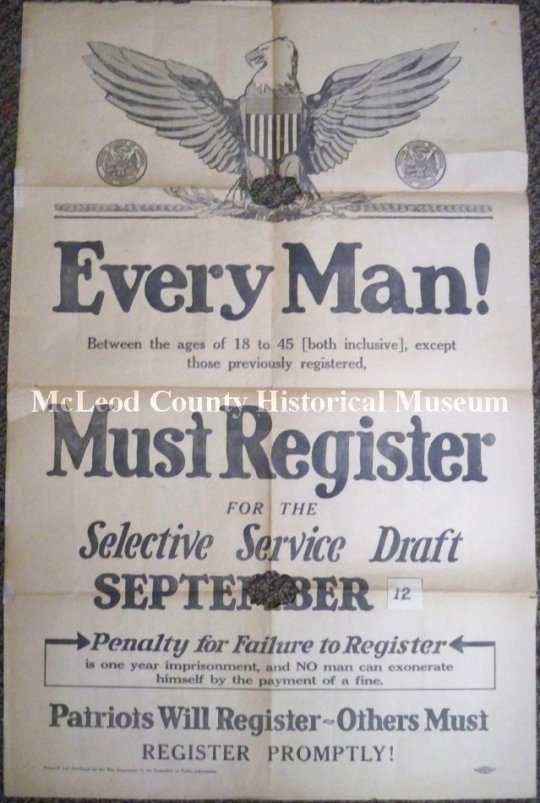
April 6, 1917 - The United States officially enters World War I
“Two days after the U.S. Senate voted 82 to 6 to declare war against Germany, the U.S. House of Representatives endorses the declaration by a vote of 373 to 50, and America formally enters World War I.
When World War I erupted in 1914, President Woodrow Wilson pledged neutrality for the United States, a position that the vast majority of Americans favored. Britain, however, was one of America’s closest trading partners, and tension soon arose between the United States and Germany over the latter’s attempted quarantine of the British Isles. Several U.S. ships traveling to Britain were damaged or sunk by German mines, and in February 1915 Germany announced unrestricted warfare against all ships, neutral or otherwise, that entered the war zone around Britain. One month later, Germany announced that a German cruiser had sunk the William P. Frye, a private American vessel. President Wilson was outraged, but the German government apologized and called the attack an unfortunate mistake.
On May 7, the British-owned Lusitania ocean liner was torpedoed without warning just off the coast of Ireland. Of the 1,959 passengers, 1,198 were killed, including 128 Americans. The German government maintained that the Lusitania was carrying munitions, but the U.S. demanded reparations and an end to German attacks on unarmed passenger and merchant ships. In August, Germany pledged to see to the safety of passengers before sinking unarmed vessels, but in November sunk an Italian liner without warning, killing 272 people, including 27 Americans. With these attacks, public opinion in the United States began to turn irrevocably against Germany.
In 1917, Germany, determined to win its war of attrition against the Allies, announced the resumption of unrestricted warfare in war-zone waters. Three days later, the United States broke diplomatic relations with Germany, and just hours after that the American liner Housatonic was sunk by a German U-boat. On February 22, Congress passed a $250 million arms appropriations bill intended to make the United States ready for war. In late March, Germany sunk four more U.S. merchant ships, and on April 2 President Wilson appeared before Congress and called for a declaration of war against Germany. Four days later, his request was granted.
On June 26, the first 14,000 U.S. infantry troops landed in France to begin training for combat. After four years of bloody stalemate along the western front, the entrance of America’s well-supplied forces into the conflict marked a major turning point in the war and helped the Allies to victory. When the war finally ended, on November 11, 1918, more than two million American soldiers had served on the battlefields of Western Europe, and some 50,000 of them had lost their lives."
- History.com
This Month in History:
April 3, 1860 - The Pony Express begins
April 9, 1959 - NASA introduces America's first astronauts
April 12, 1963 - Martin Luther King, Jr. writes "Letter from a Birmingham Jail"
April 20, 1902 - Marie and Pierre Curie isolate radium
April 24, 1800 - Library of Congress established
April 30, 1803 - United States and France conclude the Louisiana Purchase
This Selective Service Poster from World War I can be found in the online collection of the McLeod County Historical Society & Museum.
#This Day in history#world war i#selective service#museums#history museums#Minnesota museums#history#online collections#online museum collections#pastperfect#pastperfectonline
0 notes
Photo
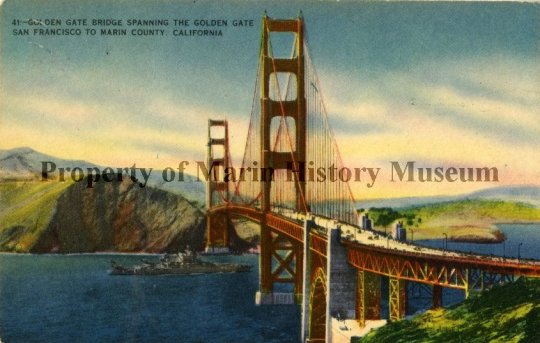
January 05, 1933 - Golden Gate Bridge is born
"On January 5, 1933, construction begins on the Golden Gate Bridge, as workers began excavating 3.25 million cubic feet of dirt for the structure’s huge anchorages.
Following the Gold Rush boom that began in 1849, speculators realized the land north of San Francisco Bay would increase in value in direct proportion to its accessibility to the city. Soon, a plan was hatched to build a bridge that would span the Golden Gate, a narrow, 400-foot deep strait that serves as the mouth of the San Francisco Bay, connecting the San Francisco Peninsula with the southern end of Marin County.
Although the idea went back as far as 1869, the proposal took root in 1916. A former engineering student, James Wilkins, working as a journalist with the San Francisco Bulletin, called for a suspension bridge with a center span of 3,000 feet, nearly twice the length of any in existence. Wilkins’ idea was estimated to cost an astounding $100 million. So, San Francisco’s city engineer, Michael M. O’Shaughnessy (he’s also credited with coming up with the name Golden Gate Bridge), began asking bridge engineers whether they could do it for less.
Engineer and poet Joseph Strauss, a 5-foot tall Cincinnati-born Chicagoan, said he could.
Eventually, O’Shaughnessy and Strauss concluded they could build a pure suspension bridge within a practical range of $25-30 million with a main span at least 4,000 feet. The construction plan still faced opposition, including litigation, from many sources. By the time most of the obstacles were cleared, the Great Depression of 1929 had begun, limiting financing options, so officials convinced voters to support $35 million in bonded indebtedness, citing the jobs that would be created for the project. However, the bonds couldn’t be sold until 1932, when San-Francisco based Bank of America agreed to buy the entire project in order to help the local economy.
The Golden Gate Bridge officially opened on May 27, 1937, the longest bridge span in the world at the time. The first public crossing had taken place the day before, when 200,000 people walked, ran and even roller skated over the new bridge.
With its tall towers and famous trademarked "international orange" paint job, the bridge quickly became a famous American landmark, and a symbol of San Francisco."
- History.com
This month in History:
January 9, 1768 - First modern circus is staged
January 12, 1932 - Hattie Wyatt Caraway becomes first woman elected to U.S. Senate
January 19, 1809 - Edgar Allan Poe is born
January 27, 1945 - Auschwitz is liberated
This color postcard of the Golden Gate Bridge can be found in the online collection of the Marin History Museum.
#This Day in History#California History#bridges#golden gate bridge#san francisco history#california#history museums#history#museums#pastperfect#pastperfect online
0 notes
Photo
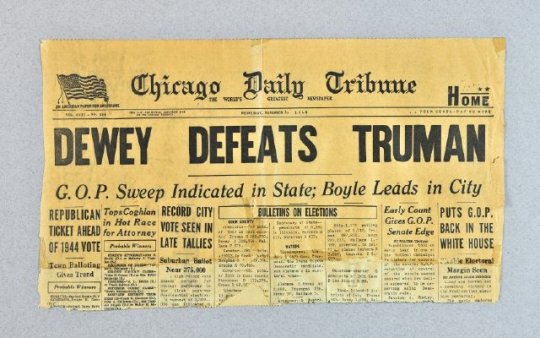
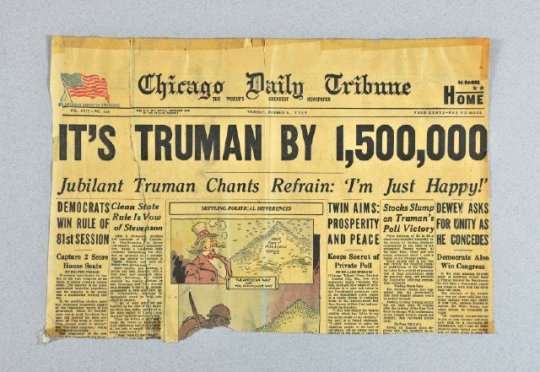
November 3, 1948 - Newspaper mistakenly declares "Dewey Defeats Truman"
"On November 3, 1948, the Chicago Tribune jumps the gun and mistakenly declares New York Governor Thomas Dewey the winner of his presidential race with incumbent Harry S. Truman in a front-page headline: “Dewey Defeats Truman.”
Many of America’s major newspapers had predicted a Dewey victory early on in the campaign. A New York Times article editorialized that “if Truman is nominated, he will be forced to wage the loneliest campaign in recent history.” Perhaps not surprisingly then, Truman chose not to use the press as a vehicle for getting his message across. Instead, in July 1948, he embarked on an ambitious 22,000-mile “whistle stop” railroad and automobile campaign tour.
At every destination, Truman asked crowds to help him keep his job as president. His eventual success in the election of 1948 has been largely attributed to this direct interaction with the public and his appeal to the common voters as the political “underdog.” At the end of one of his campaign speeches, voices in the crowd could be heard yelling “Give ’em Hell, Harry!” It didn’t take long for the phrase to catch on and become Truman’s unofficial campaign slogan.
In a now famous photograph snapped in the early morning hours after the election, a beaming and bemused Truman is shown holding aloft the Chicago Tribune issue that had wrongly predicted his political downfall. Truman defeated Dewey by 114 electoral votes."
- History.com
This week in History:
October 31, 1926 - Harry Houdini dies
November 1, 1800 - John Adams moves into White House
November 2, 1947 - Howard Hughes's "Spruce Goose" flies
November 3, 1903 - Panama declares independence from Columbia
November 4, 1922 - Entrance to King Tut's tomb discovered
November 5, 1940 - FDR re-elected for third term
November 6, 1860 - Abraham Lincoln elected president
These two newspapers (the original "Dewey Defeats Truman" and the retraction printing the next day) can be found in the online collection of Kentucky Historical Society.
#this day in history#american history#electoral history#elections#truman#dewey#presidential election#museums#historical society#history#online collections#online museum collections#pastperfect#pastperfect online
6 notes
·
View notes
Photo
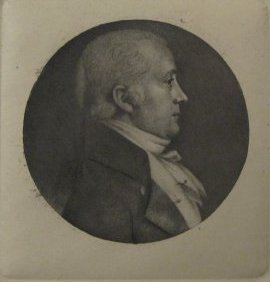
September 1, 1807 - Aaron Burr acquitted of Treason
"Former U.S. vice president Aaron Burr is acquitted of plotting to annex parts of Louisiana and Spanish territory in Mexico to be used toward the establishment of an independent republic. He was acquitted on the grounds that, though he had conspired against the United States, he was not guilty of treason because he had not engaged in an “overt act,” a requirement of the law governing treason. Nevertheless, public opinion condemned him as a traitor, and he fled to Europe.
Aaron Burr, born into a prestigious New Jersey family in 1756, graduated from the College of New Jersey (later Princeton) at the age of 17. He joined the Continental Army in 1775 and distinguished himself during the Patriot attack on Quebec. A masterful politician, he was elected to the New York State Assembly in 1783 and later served as state attorney. In 1790, he was elected to the U.S. Senate. In 1796, Burr ran for the vice presidency on Thomas Jefferson’s Democratic-Republican ticket (the forerunner of the Democratic Party), but the Federalist John Adams won the presidency. Burr left the Senate and returned to the New York Assembly.
In 1800, Jefferson again chose Burr as his running mate. Under the electoral procedure then prevailing, president and vice president were not voted for distinctly; the candidate who received the most votes was elected president, and the second in line, vice president. Jefferson and Burr each won 73 votes, and the election was sent to the House of Representatives. What at first seemed but an electoral technicality–handing Jefferson victory over his running mate–developed into a major constitutional crisis when Federalists in the lame-duck Congress threw their support behind Burr. After a remarkable 35 tie votes, a small group of Federalists changed sides and voted in Jefferson’s favor.
Burr became vice president, but Jefferson grew apart from him, and he did not support Burr’s renomination to a second term in 1804. That year, a faction of New York Federalists, who had found their fortunes drastically diminished after the ascendance of Jefferson, sought to enlist the disgruntled Burr into their party and elect him governor. Burr’s old political antagonist Alexander Hamilton campaigned against him with great fervor, and he lost the Federalist nomination and then, running as an independent for governor, the election. In the campaign, Burr’s character was savagely attacked by Hamilton and others, and after the election he resolved to restore his reputation by challenging Hamilton to a duel, or an “affair of honor,” as they were known.
Affairs of honor were commonplace in America at the time, and the complex rules governing them usually led to a resolution before any actual firing of weapons. In fact, the outspoken Hamilton had been involved in several affairs of honor in his life, and he had resolved most of them peaceably. No such recourse was found with Burr, however, and on July 11, 1804, the enemies met at 7 a.m. at the dueling grounds near Weehawken, New Jersey.
There are conflicting accounts of what happened next. According to Hamilton’s “second”—his assistant and witness in the duel—Hamilton decided the duel was morally wrong and deliberately fired into the air. Burr’s second claimed that Hamilton fired at Burr and missed. What happened next is agreed upon: Burr shot Hamilton in the stomach, and the bullet lodged next to his spine. Hamilton was taken back to New York, and he died the next afternoon.
Few affairs of honor actually resulted in deaths, and the nation was outraged by the killing of a man as eminent as Alexander Hamilton. Charged with murder in New York and New Jersey, Burr, still vice president, returned to Washington, D.C., where he finished his term immune from prosecution.
In 1805, Burr, thoroughly discredited, concocted a plot with James Wilkinson, commander-in-chief of the U.S. Army, to seize the Louisiana Territory and establish an independent empire, which Burr, presumably, would lead. He contacted the British government and unsuccessfully pleaded for assistance in the scheme. Later, when border trouble with Spanish Mexico heated up, Burr and Wilkinson conspired to seize territory in Spanish America for the same purpose.
In the fall of 1806, Burr led a group of well-armed colonists toward New Orleans, prompting an immediate U.S. investigation. General Wilkinson, in an effort to save himself, turned against Burr and sent dispatches to Washington accusing Burr of treason. In February 1807, Burr was arrested in Louisiana for treason and sent to Virginia to be tried in a U.S. court. On September 1, he was acquitted on a technicality. Nevertheless, the public condemned him as a traitor, and he went into exile to Europe. He later returned to private life in New York, the murder charges against him forgotten. He died in 1836."
- History.com
This week in History:
August 29, 1876 - Charles F. Kettering, inventor of the electric self-starter, is born
August 30, 1983 - Guion S. Blueford becomes first African-American to travel to space
August 31, 1897 - Thomas Edison patents the Kinetograph
September 1, 1985 - Wreck of Titanic Found
September 2, 1945 - Japan surrenders, bringing an end to WWII
September 3, 1783 - Treaty of Paris signed
September 4, 1951 - President Truman makes first transcontinental television broadcast
This engraving of Aaron Burr can be found in the online collection of the Fraunces Tavern Museum.
#this day in history#museums#new york museums#aaron burr#fraunces tavern museum#history#american history#history museums#pastperfect#pastperfectonline
0 notes
Photo
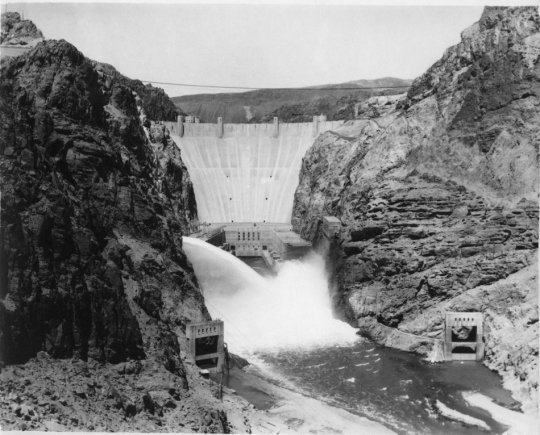
July 7, 1930 - Building of Hoover Dam begins
"On July 7, 1930, construction of the Hoover Dam begins. Over the next five years, a total of 21,000 men would work ceaselessly to produce what would be the largest dam of its time, as well as one of the largest manmade structures in the world.
Although the dam would take only five years to build, its construction was nearly 30 years in the making. Arthur Powell Davis, an engineer from the Bureau of Reclamation, originally had his vision for the Hoover Dam back in 1902, and his engineering report on the topic became the guiding document when plans were finally made to begin the dam in 1922.
Herbert Hoover, the 31st president of the United States and a committed conservationist, played a crucial role in making Davis’ vision a reality. As secretary of commerce in 1921, Hoover devoted himself to the erection of a high dam in Boulder Canyon. The dam would provide essential flood control, which would prevent damage to downstream farming communities that suffered each year when snow from the Rocky Mountains melted and joined the Colorado River. Further, the dam would allow the expansion of irrigated farming in the desert, and would provide a dependable supply of water for Los Angeles and other southern California communities.
Even with Hoover’s exuberant backing and a regional consensus around the need to build the dam, Congressional approval and individual state cooperation were slow in coming. For many years, water rights had been a source of contention among the western states that had claims on the Colorado River. To address this issue, Hoover negotiated the Colorado River Compact, which broke the river basin into two regions with the water divided between them. Hoover then had to introduce and re-introduce the bill to build the dam several times over the next few years before the House and Senate finally approved the bill in 1928.
In 1929, Hoover, now president, signed the Colorado River Compact into law, claiming it was “the most extensive action ever taken by a group of states under the provisions of the Constitution permitting compacts between states.”
Once preparations were made, the Hoover Dam’s construction sprinted forward: The contractors finished their work two years ahead of schedule and millions of dollars under budget. Today, the Hoover Dam generates enough energy each year to serve over a million people, and stands, in Hoover Dam artist Oskar Hansen’s words, as “a monument to collective genius exerting itself in community efforts around a common need or ideal.”"
- History.com
This week in History:
July 4, 1884 - France gives the Statue of Liberty to the United States
July 5, 1865 - Salvation Army founded
July 6, 1976 - Women inducted into U.S. Naval Academy for first time
July 7, 1912 - Jim Thorpe begins Olympic triathlon
July 8, 1776 - Liberty Bell tolls to announce Declaration of Independence
July 9, 1947 - First female army officer is appointed
July 10, 1925 - Scopes Monkey Trial begins
This image of the Hoover Dam in 1936 can be found in the online collection of the Nevada State Museum Las Vegas.
#this day in history#museums#history#history museums#nevada history#nevada state museum#hoover dam#lake mead#boulder dam#pastperfect#pastperfect online
0 notes
Photo

May 5, 1961: Alan Shepard becomes the first American in space
"From Cape Canaveral, Florida, Navy Commander Alan Bartlett Shepard Jr. is launched into space aboard the Freedom 7 space capsule, becoming the first American astronaut to travel into space. The suborbital flight, which lasted 15 minutes and reached a height of 116 miles into the atmosphere, was a major triumph for the National Aeronautics and Space Administration (NASA).
NASA was established in 1958 to keep U.S. space efforts abreast of recent Soviet achievements, such as the launching of the world’s first artificial satellite–Sputnik 1–in 1957. In the late 1950s and early 1960s, the two superpowers raced to become the first country to put a man in space and return him to Earth. On April 12, 1961, the Soviet space program won the race when cosmonaut Yuri Gagarin was launched into space, put in orbit around the planet, and safely returned to Earth. One month later, Shepard’s suborbital flight restored faith in the U.S. space program.
NASA continued to trail the Soviets closely until the late 1960s and the successes of the Apollo lunar program. In July 1969, the Americans took a giant leap forward with Apollo 11, a three-stage spacecraft that took U.S. astronauts to the surface of the moon and returned them to Earth. On February 5, 1971, Alan Shepard, the first American in space, became the fifth astronaut to walk on the moon as part of the Apollo 14 lunar landing mission."
- History.com
This week in History:
May 2, 1670 - King Charles II grants charter to Hudson's Bay Company
May 3, 1954 - Supreme Court rules in Hernandez v. Texas
May 4, 1961 - The first Freedom Ride departs from Washington, D.C.
May 5, 1921 - Chanel No. 5 perfume launches
May 6, 1937 - The Hindenburg disaster
May 7, 1994 - Edvard Munch's "The Scream" recovered after theft
May 8, 1945 - V-E Day celebrated in America and Britain
This photograph of Commander Alan Shepard can be found in the online collection of the Navy Seal Museum.
#This Day in History#Museums#history#military museums#space#Alan Shepard#NASA#NASA history#Navy Seal Museum#pastperfect#pastperfect online
1 note
·
View note
Photo
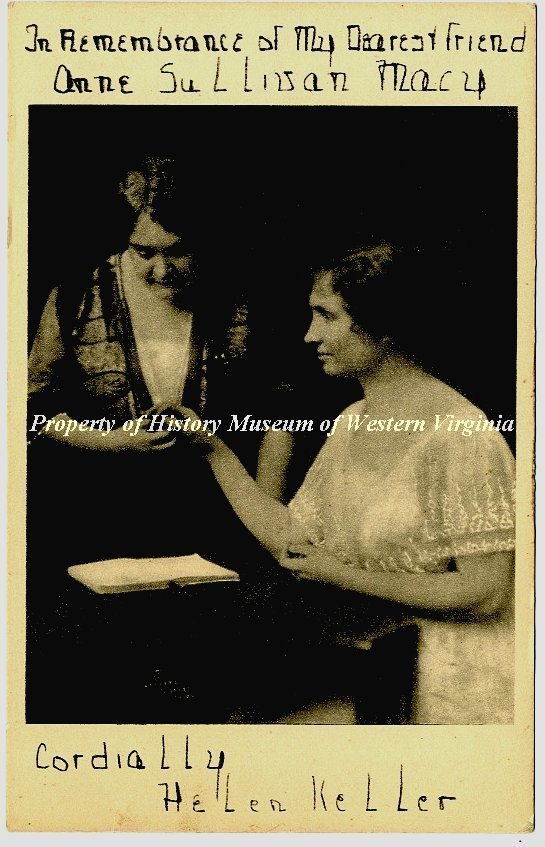
March 3, 1887 - Helen Keller meets Anne Sullivan, her teacher and “miracle worker”
"On March 3, 1887, Anne Sullivan begins teaching six-year-old Helen Keller, who lost her sight and hearing after a severe illness at the age of 19 months. Under Sullivan’s tutelage, including her pioneering “touch teaching” techniques, the previously uncontrollable Keller flourished, eventually graduating from college and becoming an international lecturer and activist. Sullivan, later dubbed “the miracle worker,” remained Keller’s interpreter and constant companion until the older woman’s death in 1936.
Sullivan, born in Massachusetts in 1866, had firsthand experience with being handicapped: As a child, an infection impaired her vision. She then attended the Perkins Institution for the Blind where she learned the manual alphabet in order to communicate with a classmate who was deaf and blind. Eventually, Sullivan had several operations that improved her weakened eyesight.
Helen Adams Keller was born on June 27, 1880, to Arthur Keller, a former Confederate army officer and newspaper publisher, and his wife Kate, of Tuscumbia, Alabama. As a baby, a brief illness, possibly scarlet fever or a form of bacterial meningitis, left Helen unable to see, hear or speak. She was considered a bright but spoiled and strong-willed child. Her parents eventually sought the advice of Alexander Graham Bell, the inventor of the telephone and an authority on the deaf. He suggested the Kellers contact the Perkins Institution, which in turn recommended Anne Sullivan as a teacher.
Sullivan, age 20, arrived at Ivy Green, the Keller family estate, in 1887 and began working to socialize her wild, stubborn student and teach her by spelling out words in Keller’s hand. Initially, the finger spelling meant nothing to Keller. However, a breakthrough occurred one day when Sullivan held one of Keller’s hands under water from a pump and spelled out “w-a-t-e-r” in Keller’s palm. Keller went on to learn how to read, write and speak. With Sullivan’s assistance, Keller attended Radcliffe College and graduated with honors in 1904.
Helen Keller became a public speaker and author; her first book, “The Story of My Life” was published in 1902. She was also a fundraiser for the American Foundation for the Blind and an advocate for racial and sexual equality, as well as socialism. From 1920 to 1924, Sullivan and Keller even formed a vaudeville act to educate the public and earn money. Helen Keller died on June 1, 1968, at her home in Easton, Connecticut, at age 87, leaving her mark on the world by helping to alter perceptions about the disabled."
- History.com
This week in History:
February 28, 1861 - Congress creates Colorado Territory
March 1, 1961 - President Kennedy establishes the Peace Corps
March 2, 1836 - Texas declares independence
March 3, 1875 - First indoor game of ice hockey
March 4, 1918 - First cases reported in deadly Spanish Flu pandemic
March 5, 1963 - Hula Hoop patented
March 6, 1820 President Monroe signs the Missouri Compromise
This photograph of Anne Sullivan Macy and Hellen Keller can be found in the online collection of the O. Winston Link Museum/History Museum of Western Virginia.
#History#helen keller#anne sullivan#american foundation for the blind#this day in history#history museums#historical societies#museum collections#online collections#pastperfect#pastperfect online
2 notes
·
View notes
Photo
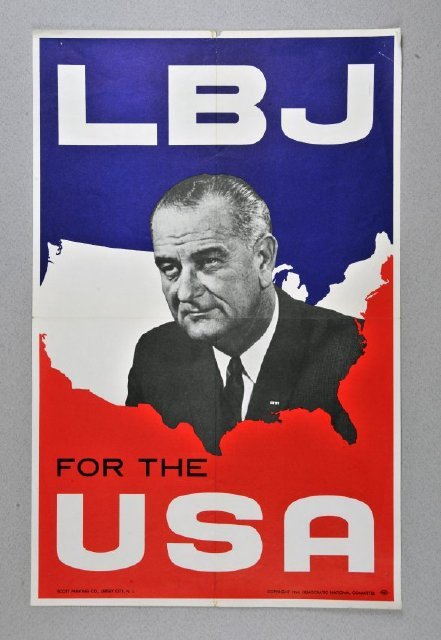
January 4, 1965 - L.B.J. envisions a Great Society in his State of the Union address
"On January 4, 1965, in his State of the Union address, President Lyndon Baines Johnson lays out for Congress a laundry list of legislation needed to achieve his plan for a Great Society. On the heels of John F. Kennedy’s tragic death, Americans had elected Johnson, his vice president, to the presidency by the largest popular vote in the nation’s history. Johnson used this mandate to push for improvements he believed would better Americans’ quality of life.
Following Johnson’s lead, Congress enacted sweeping legislation in the areas of civil rights, health care, education and the environment. The 1965 State of the Union address heralded the creation of Medicare/Medicaid, Head Start, the Voting Rights Act, the Civil Rights Act, the Department of Housing and Urban Development and the White House Conference on Natural Beauty. Johnson also signed the National Foundation of the Arts and Humanities Act, out of which emerged the National Endowment for the Arts and the National Endowment for the Humanities. Through the Economic Opportunity Act, Johnson fought a War on Poverty by implementing improvements in early childhood education and fair employment policies. He was also a strong advocate for conservation, proposing the creation of a green legacy through preserving natural areas, open spaces and shorelines and building more urban parks. In addition, Johnson stepped up research and legislation regarding air- and water-pollution control measures.
Under Kennedy, then-Vice President Johnson led the government’s quest to develop American excellence in the sciences. As president, the ongoing technology race with the Soviet Union spurred Johnson to continue the vigorous national program of space exploration begun by Kennedy. During Johnson’s presidency, the National Air and Space Administration (NASA) achieved the extraordinary and unprecedented accomplishment of orbiting a man around the moon.
Though many of Johnson’s programs remain in place today, his legacy of a Great Society has been largely overshadowed by his decision to involve greater numbers of American soldiers in the controversial Vietnam War."
- History.com
Other events in history this week:
January 3, 1959 - Alaska becomes 49th state
January 4, 1896 - Utah enters the Union
January 5, 1933 - Golden Gate Bridge is born
January 6, 1938 - Samuel Morse demonstrates the telegraph
January 7, 1789 - First United States presidential election
January 8, 1815 - The Battle of New Orleans
January 9, 1768 - First modern circus is staged
This political poster for Lyndon B. Johnson can be found in the online collection of the Kentucky Historical Society.
#history#museums#kentucky museums#presidents#presidential history#lbj#Lyndon Johnson#history museums#historical societies#this day in history#this week in history#pastperfect#pastperfect online
2 notes
·
View notes
Photo
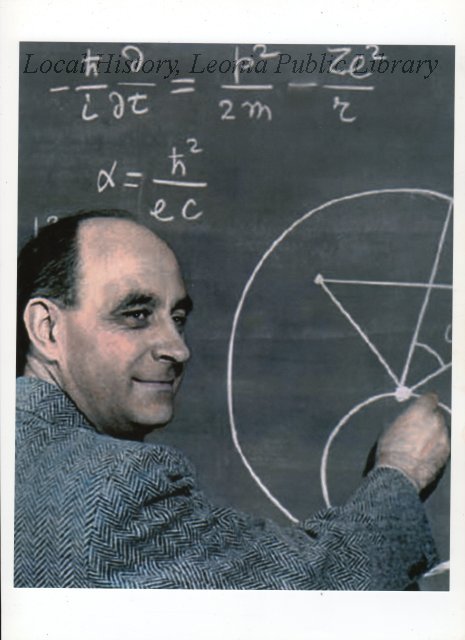
December 2, 1942 - Physicist Enrico Fermi produces the first nuclear chain reaction
"Enrico Fermi, the Italian-born Nobel Prize-winning physicist, directs and controls the first nuclear chain reaction in his laboratory beneath the bleachers of Stagg Field at the University of Chicago, ushering in the nuclear age. Upon successful completion of the experiment, a coded message was transmitted to President Roosevelt: “The Italian navigator has landed in the new world.”
Following on England’s Sir James Chadwick’s discovery of the neutron and the Curies’ production of artificial radioactivity, Fermi, a full-time professor of physics at the University of Florence, focused his work on producing radioactivity by manipulating the speed of neutrons derived from radioactive beryllium. Further similar experimentation with other elements, including uranium 92, produced new radioactive substances; Fermi’s colleagues believed he had created a new “transuranic” element with an atomic number of 93, the result of uranium 92 capturing a neuron while under bombardment, thus increasing its atomic weight. Fermi remained skeptical about his discovery, despite the enthusiasm of his fellow physicists. He became a believer in 1938, when he was awarded the Nobel Prize in physics for “his identification of new radioactive elements.” Although travel was restricted for men whose work was deemed vital to national security, Fermi was given permission to leave Italy and go to Sweden to receive his prize. He and his wife, Laura, who was Jewish, never returned; both feared and despised Mussolini’s fascist regime.
Fermi immigrated to New York City–Columbia University, specifically, where he recreated many of his experiments with Niels Bohr, the Danish-born physicist, who suggested the possibility of a nuclear chain reaction. Fermi and others saw the possible military applications of such an explosive power, and quickly composed a letter warning President Roosevelt of the perils of a German atomic bomb. The letter was signed and delivered to the president by Albert Einstein on October 11, 1939. The Manhattan Project, the American program to create its own atomic bomb, was the result.
It fell to Fermi to produce the first nuclear chain reaction, without which such a bomb was impossible. He created a jury-rigged laboratory with the necessary equipment, which he called an “atomic pile,” in a squash court in the basement of Stagg Field at the University of Chicago. With colleagues and other physicists looking on, Fermi produced the first self-sustaining nuclear chain reaction and the “new world” of nuclear power was born."
-History.com
This week in History:
November 29, 1942 - Coffee rationing begins
November 30, 1864 - Battle of Franklin, Tennessee
December 1, 1955 - Rosa Parks ignites bus boycott
December 2, 1777 - Philadelphia nurse Lydia Darragh overhears British plans to attack Washington's army
December 3, 1967 - First human heart transplant (1818- Illinois becomes the 21st state)
December 4, 1783 - George Washington bids farewell to his officers
December 5, 1933 - 21st amendment is ratified; Prohibition ends
This photograph of Enrico Fermi can be found in the online collection of the Leonia Public Library.
#this day in history#physics#physics history#american history#nobel prize#manhattan project#nuclear power#history collections#museums and libraries#leonia public library#pastperfect#pastperfect online
0 notes